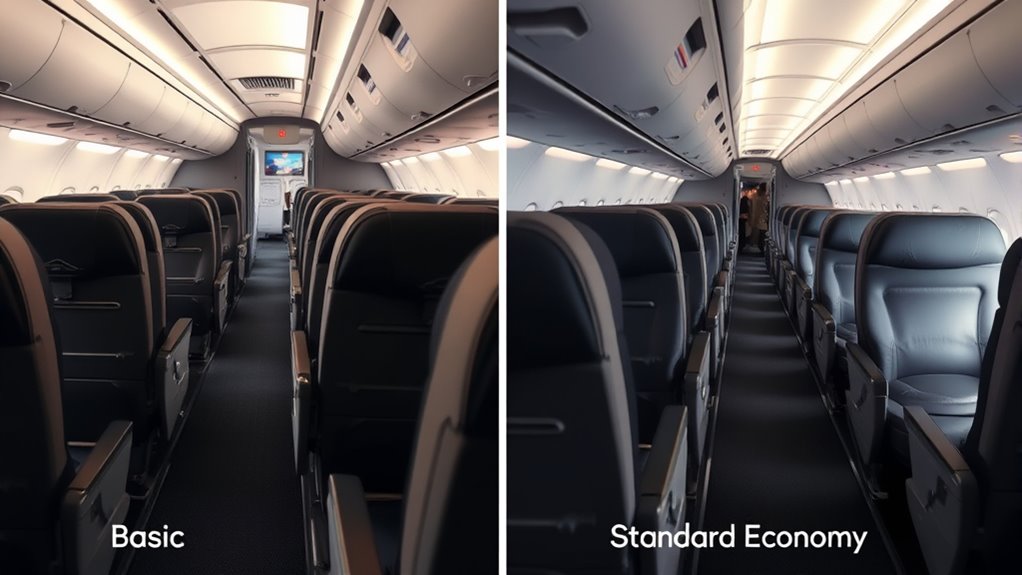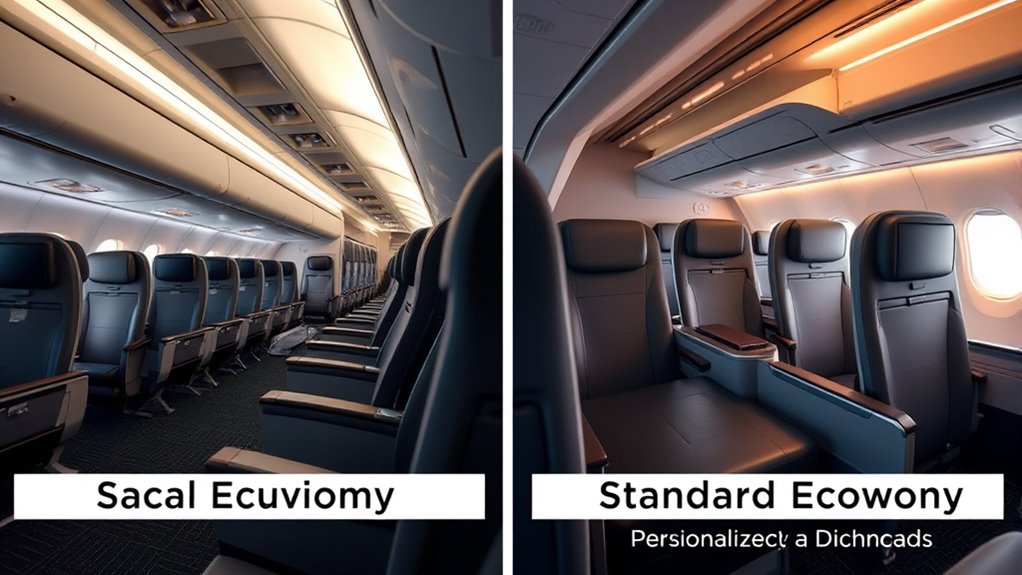Basic economy is the most affordable option, but it comes with strict restrictions like no advance seat selection and limited baggage allowances. You’ll only get a personal item and may pay extra for carry-on bags or checked luggage. Standard economy costs a bit more but offers more flexibility, baggage options, and the ability to choose seats in advance. To understand which fare fits your travel style and how to avoid surprises, keep exploring the details.
Key Takeaways
- Basic economy is the most affordable option with strict restrictions, while standard economy offers more flexibility and amenities.
- Basic economy typically allows only a personal item, with extra fees for carry-on and checked baggage; standard economy usually includes carry-on and checked bags.
- Seat selection and flight changes are limited or unavailable in basic economy, whereas standard economy permits more options and flexibility.
- Basic economy fares are lower but may involve additional fees and restrictions, leading to a less comfortable travel experience.
- Standard economy provides more control over your seat, baggage, and itinerary, making it more suitable for travelers prioritizing convenience.

When choosing between basic economy and standard economy, understanding their differences can help you make the best travel decision. These two fare types are common across airlines, but they come with distinct rules, especially regarding airline policies and baggage allowances. Knowing what to expect can save you surprises and extra fees at the airport.
Basic economy fares are designed to be the most affordable option, but they come with strict restrictions. Airlines often limit your flexibility, and their policies reflect this. For example, airline policies for basic economy usually mean you can’t select your seat in advance, and you might be assigned a seat randomly at check-in. This can be inconvenient if you prefer a window or aisle seat. Additionally, basic economy tickets often restrict changes or cancellations, so if your plans shift, you might lose your fare or face hefty fees. These fares typically include a more limited baggage allowance, often only allowing a personal item like a small backpack or purse, with no option to bring a regular carry-on bag. If you need more luggage, you’ll likely have to pay additional fees, which can quickly add up.
In contrast, standard economy offers more flexibility and generally adheres to the airline’s regular policies. With standard economy, you’re usually able to select your seat in advance, giving you more control over your travel experience. The airline policies tend to be more accommodating for changes and cancellations, often allowing free or low-cost modifications, which is helpful if your plans are uncertain. Baggage allowances are also more generous in standard economy. You can typically bring one or two checked bags, depending on the airline, along with a carry-on bag that fits in the overhead bin. This flexibility means you’re less likely to pay extra fees at the airport, making your trip smoother. Additionally, many airlines now incorporate high-quality projectors into their in-flight entertainment systems, enhancing your overall travel experience.
Deciding between the two comes down to how much you value flexibility and comfort versus cost savings. If you’re trying to keep expenses low and don’t mind sacrificing comfort, basic economy can be a good choice, but you need to be prepared for strict airline policies and limited baggage allowances. On the other hand, if you prefer more options, fewer restrictions on your baggage, and a bit more comfort, standard economy is worth the extra cost. Ultimately, understanding each fare’s airline policies and baggage allowances helps you avoid unexpected fees and makes your travel experience less stressful.
Frequently Asked Questions
Can I Upgrade From Basic Economy to Standard Economy Later?
Yes, you can upgrade from basic economy to standard economy later, but it depends on the airline’s upgrade options and fare adjustments. Typically, you’ll need to pay the difference in fare, which varies based on availability and how close to your departure date you upgrade. Check with your airline’s policies, as some may allow upgrades at any time, while others restrict upgrades to certain periods before departure.
Are There Any Loyalty Points Differences Between the Two Fares?
Your loyalty points accrual and frequent flyer benefits are generally the same whether you fly Basic Economy or Standard Economy, so it’s not like one is a points paradise while the other’s a wasteland. However, some airlines may restrict perks or bonus points with Basic fares. Always check your airline’s specific policies, because even small differences can feel like winning the lottery when it comes to earning rewards!
Which Fare Offers More Flexibility for Last-Minute Changes?
Standard Economy fares offer more flexibility for last-minute changes and better ticket flexibility overall. You can typically change your flight date or time with fewer restrictions and often for a fee or fare difference. Basic Economy tickets usually have strict policies, making last-minute changes difficult or impossible. If your plans are uncertain, choosing Standard Economy helps you adapt without significant penalties, giving you peace of mind for last-minute adjustments.
Do Both Fares Include In-Flight Entertainment Options?
In-flight amenities differ between fares; Standard Economy generally offers more entertainment options, like seat-back screens and Wi-Fi, while Basic Economy often limits these features. You might find that in-flight entertainment options are more plentiful on the standard fare, making your flight feel like a moving theater. Basic Economy passengers may need to bring their own devices or download entertainment beforehand, as in-flight amenities are more restricted.
How Do Baggage Policies Differ Beyond the Basic Allowance?
You’ll find that baggage policies beyond the basic allowance differ markedly. With Standard Economy, you usually get a free carry-on, but Basic Economy often restricts carry-on restrictions, requiring you to pay baggage fees for larger bags. In some cases, you might only be allowed a personal item. Always check airline policies beforehand to avoid extra charges, as baggage fees and carry-on restrictions can catch you off guard at the gate.
Conclusion
So, which option suits you best—basic economy or standard economy? Think about what you value most: saving money or enjoying extra comforts and flexibility. Would you rather travel light and pay less, or prefer a bit more space and perks? Ultimately, your choice depends on your priorities and budget. Both options have their merits, but only you can decide which one makes your journey smoother and more enjoyable. What will you choose—the basics or the extras?









